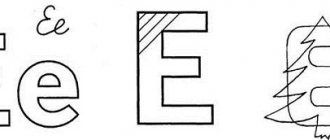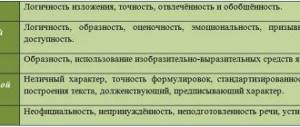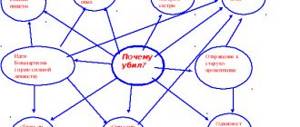Implementation of a system-activity approach in the classroom when teaching physics; Promotion of innovative ideas related to the formation of the foundations of a scientific research culture among the younger generation. Goal: To create conditions for a meaningful understanding of the significance of new discoveries using the example of the discovery of a jet type of propulsion, which “opened the road to space.”
Lesson objectives:
- Educational: ensure the assimilation of the concept of “reactive motion” and an explanation of reactive motion based on the law of conservation of momentum.
- Developmental: develop cognitive interests and creative abilities; contribute to broadening your horizons; give every student the opportunity to feel their potential; to form an idea of the role of “physics” in the life of society.
- Educational: to cultivate a sense of pride in our country and people; cultivate independence and initiative; to cultivate an aesthetic perception of the world through demonstration and clarity; to cultivate a caring attitude towards the world around us: nature, space.
During the classes
Organizing time
Greetings.
Today I want to start the lesson with the epigraph of M.V. Lomonosov (the founder of physics in Russia) “An abyss has opened, it’s full of stars... There are no stars in number, an abyss...”.
Humanity has long been fascinated by the cosmic sky. The dream of getting there was unattainable. Our task today in class: To study a new type of movement that allowed us to “open the road to space.”
Lesson topic: JET MOTION. ROCKETS.
Updating knowledge and recording difficulties in activities
Say: What is the cause of mechanical movement (change in speed)? (7th grade)
- Interaction.
—Can one body interact?
- No. At least two bodies.
— The well-known dreamer Munchausen, told us tales about how he pulled himself out of the swamp?
- Yes.
— Everyone thought so, knowing the known laws of physics at that time. But! Discoveries belong to those minds that question, seek and find other solutions to a given problem. These are innovators. Such an innovator was a simple rural physics teacher, Konstantin Eduardovich Tsiolkovsky, who, in addition to knowing the laws of physics well, was very observant, inquisitive, and without questioning the laws of mechanical motion, was able to discover a new type of motion. Let us also try to follow his path of observations and reasoning. Will we be able to make a discovery?
Setting a learning task
To begin with, let’s draw up an action plan: (observation; modeling the situation; definition; experience; significance)
- Observations of non-mechanical movements.
- Analyze this type of movement in a situational picture.
- Formulate a definition of jet propulsion.
- Conduct an experiment that would determine the parameters on which the speed of jet propulsion depends.
- Consider the significance of the discovery using the example of a rocket.
Building a project to get out of a problem
Let's start working according to plan:
Working with slides:
1. Look at the movement of sea inhabitants: jellyfish, cuttlefish. Find the interacting bodies that cause the movement (or are they not there?). What can you say about these bodies (this body)? (the water-jellyfish was one single whole body).
2. A man put balls into a boat and intends to move along the river without oars. Is it possible? (Refer to your life experience and powers of observation). How to do this effectively? (throw the balls one at a time or all together? in different directions or in one? take into account the speed of throwing the balls or not?).
Formulate the definition of jet propulsion:
Reactive motion is the movement of a body that occurs when some part of it is separated from it at any speed.
Primary consolidation
Let's do an experiment with three balloons. Three pairs of students work on the first desks (in three rows).
1 pair: Large inflatable ball.
2 pair: Balloon with smaller volume..
3 pair: Large balloon with a nut inside.
After discussing flights, we highlight the features:
We observe: Whose ball will fly higher?
The task for everyone: what parameters will determine the flight range.
After joint discussions, we conclude:
The flight range of a rocket depends on:
- on the gas pressure inside the projectile.
- from the mass of the system.
The rocket opened the way to space. Video - rocket launch.
- Why can’t we leave the solar system on a jet rocket? (there is a limit to the strength of the rocket material (if the ball bursts in the experiment, this is proof), the mass of the fuel is limited).
— Physics needs new innovators (we need a “second Tsiolkovsky”) who would find a new type of motion and allow humanity to look beyond the solar system.
Independent work with self-test according to the standard
Assignment: make mini-reports in groups according to plan. (You can continue working on your reports at home.)
Group 1: Rockets. Page 85 fig. 45. textbook.
Message plan:
- Diagram of the rocket (what it consists of, list and show its main components).
- Indicate the purpose of each part (for what),
- Note features and interesting points (if any).
Group 2: Living rockets.
Message plan:
- An example of jet propulsion in the plant world, note interesting facts.
- An example of an engineering design (water cannon), note how it works.
Group 3: From the history of rocket propulsion.
Message plan:
- Sanger wheel. Demonstration.
- The first project of cars (use the picture to talk about movement, linking the definition of jet propulsion formulated in the lesson).
Group 4: From the history of jet propulsion.
Message plan:
- The first signal flares in China (when they appeared, note interesting details).
- Offer a solution to the problem described in the legend of the rich man with a bag of gold.
Group 5: About the Great People of the Space Age..
Message plan:
- K.E. Tsiolkovsky (who they think and why, interesting facts from childhood)
- S.P. Korolev (creator of the rocket, satellite, human spacewalk).
Group 6: About the Great People of the Space Age..
Message plan:
- Yu.A. Gagarin (first cosmonaut, flight time, Cosmonautics Day).
- V.N. Tereshkova (peasant family, date of flight, name of the ship, famous phrase about a mistake in flight, landing - there is a monument in Altai).
Reflection of activity
Has the lesson goal been achieved? (learned a new type of movement)
Give yourself a self-assessment in the margins of your notebook, which would reflect the degree to which you have mastered the topic of the lesson, and next to it is a smiley face of your mood during the lesson.
Do you have a desire to study jet propulsion and space achievements in more detail?
8. You will have the following opportunity: D/z : p 22 read, messages at will, home experiment (Internet).
Jet propulsion, video
And finally, an entertaining video about physical experiments with jet propulsion.
Author: Pavel Chaika, editor-in-chief of Poznavaika magazine
When writing the article, I tried to make it as interesting, useful and high-quality as possible. I would be grateful for any feedback and constructive criticism in the form of comments on the article. You can also write your wish/question/suggestion to my email [email protected] or Facebook, with respect, the author.
Author page
Material for reports
Group 2: Living rockets
In nature you can often find reactive motion, for example:
cuttlefish and octopuses also use the reactive principle of movement when moving in water. By drawing water into themselves, they, pushing it out, acquire a speed directed in the direction opposite to the direction of the release of water. The squid is the largest invertebrate inhabitant of the ocean depths. It moves according to the principle of jet propulsion, absorbing water, and then with enormous force pushes it through a special hole - a “funnel”, and with high speed (about 70 km/h) pushes backwards. At the same time, all ten tentacles of the squid are gathered into a knot above its head, and it takes on a streamlined shape.
The ripe fruits of the “mad” cucumber bounce off the stalk with the lightest touch, the seeds are thrown out of the cucumber with force, and the cucumber itself flies off in the opposite direction. The resulting bluish-green oval fruit-boxes are covered with soft thorns. Crazy cucumber is used as an ornamental plant for hedges; the fruits are used fresh and pickled. Used as a medicinal plant in homeopathy.
Water jet propulsion (water cannon); a marine engine in which the force moving the vessel is created by a stream of water pushed out of it.
Advantages:
- At high speeds it provides maximum speed and fuel economy.
- The coast-down of the vessel during emergency braking is the shortest.
- The vessel can turn around on the spot
- Possibility of passage of the vessel in shallow water.
Flaws:
- Difficulty in supplying water through the bottom of the vessel to the pump.
- The need to transport water as a working fluid and cargo at the same time.
- Power loss due to friction of water in pipelines.
- Power loss due to turbulent turbulence of the water flow in the water jet channels.
- The degree of wear of the rotor-stator pair is high, since operation is carried out in shallow water, repairs are more expensive compared to a conventional propeller.
Group 3: From the history of rocket propulsion
Group 4: From the history of jet propulsion
1. The true homeland of the rocket is China. Already in ancient China, long before our era, the so-called throwing of fiery jet arrows was widely used.
Chinese fire arrow
Being much older and older than firearms, the rocket has long been used in the East as a military method of intimidating the enemy, setting fire to military camps and besieged fortresses and cities, causing panic and superstition in the ranks of enemy troops, etc.
At the same time, rocket technology, which found such wide application in military affairs, could not help but take purely scientific technical forms.
2. There is an old legend about a rich man with a bag of gold, who, finding himself on the absolutely smooth ice of a lake, froze, but did not want to part with his wealth. How could he have saved himself if he had not been so greedy?
Group 5: About Great People of the Space Age
KONSTANTIN TSIOLKOVSKY: “First inevitably come: thought, fantasy, fairy tale. They are followed by scientific calculation and, in the end, execution crowns thought.”
Konstantin Eduardovich Tsiolkovsky was born in September 1857 in the village of Izhevsk, Ryazan province. Tsiolkovsky grew up as a lively, intelligent and impressionable child. From the age of 14, Tsiolkovsky began to study independently, using his father’s small library. He spent all his time studying, doing experiments in physics and chemistry, and reading a lot. In 1876, his parents, having heard about their son’s half-starved existence in Moscow, demanded that he come home. In 1880, he was appointed to the position of teacher of arithmetic and geometry at the Borovsk district school in the Kaluga province.
In his old age he became interested in jet aircraft. Later, Tsiolkovsky came up with the idea of multi-stage ones. He also laid the foundations for calculating the flight of these missiles. Many of Tsiolkovsky's predictions turned out to be extremely accurate. He, for example, colorfully and very accurately described the sensations that a person will experience during the launch of a rocket and when it enters outer space, as well as what he will see there. His imagination was far ahead of its time; Tsiolkovsky was firmly convinced that humanity’s entry into space was completely inevitable and that it was space exploration that would help solve many of the modern problems of earthlings.
Sergei Pavlovich Korolev
In our country, the word cosmos is primarily associated with the surname Korolev. Sergei Pavlovich was born in January 1907, in the city of Zhitomir. His father, Pavel Yakovlevich, was a simple teacher, his mother Maria Nikolaevna Moskalenko was also a teacher. As a child, Sergei differed from his peers in his passion for technology. Passion multiplied by talent always yields great results. During his studies in Moscow, Sergei Pavlovich established himself as a talented designer.
Korolev's fate was difficult. In 1938, he went to prison on trumped-up charges. Two years later, the state still needed his services. In 1946, Sergei Pavlovich was appointed chief designer of ballistic missiles. The next step in his life was the development of a launch vehicle for atomic warheads. In 1956, the first domestically produced missile with a nuclear warhead was put into service. Soon the USSR began a space exploration program. Sergei Pavlovich created the first manned spacecraft in world history. The name of the ship is “Vostok”.
On this ship, a man flew into space for the first time.
Law of Jet Propulsion
Squids, “mad cucumbers”, jellyfish and other cuttlefish have been using jet motion since ancient times, without thinking about its physical essence, but we will try to figure out what the essence of jet motion is, what kind of motion is called jet motion, and give it a definition.
To begin with, you can resort to a simple experiment - if you inflate an ordinary balloon with air and, without stopping, let it fly, it will fly rapidly until its air supply is used up. This phenomenon is explained by Newton's third law, which says that two bodies interact with forces equal in magnitude and opposite in direction.
That is, the force of the ball’s influence on the air streams escaping from it is equal to the force with which the air pushes the ball away from itself. A rocket works on a similar principle to a ball, which ejects part of its mass at enormous speed, while receiving strong acceleration in the opposite direction.



